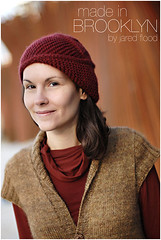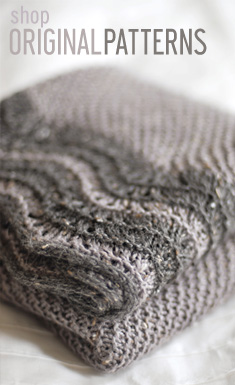b r o o k l y n t w e e d
4.20.2008
Anatomy of a Handspun: Part II
Welcome back to the second half of our anatomy lesson. Today all the fun stuff happens - we'll be turning fiber into yarn through a few simple steps. To answer a couple of questions from last time, I spin with a Kromski Minstrel, (you'll see it in today's pictures) and yes, I love my wheel. It's an upright double treadle that is compact enough to fit into small apartments without being cumbersome and is an aesthetically pleasing piece aside from its upstanding functionality. Both big priorities in my book.
Now, lets do some spinning, shall we?

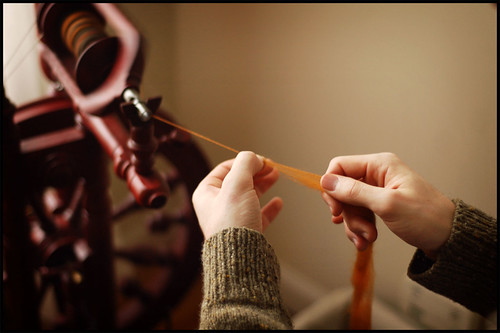
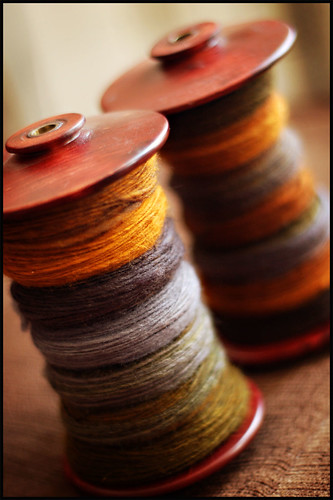
Above we have two bobbins of singles in more or less equal amounts. Before spinning I made sure to divide the fiber evenly into two parts in hopes of maximizing the yardage of the finished, plied yarn. You can see clearly on the bobbins how cleanly separated the color fields have spun out. If we were to knit this yarn up as-is, we would see clean, dramatic color stripes in our finished fabric. Plying them together, however, will essentially have the effect of mixing paint - the colors will come together somewhat randomly to diffuse or enhance one another, depending on their individual combinations. This is to me one of the best things about spinning plied yarns from hand-dyed fibers.
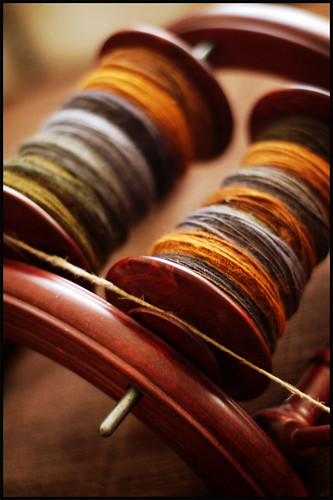
Before plying, I like to load my bobbins on a tensioned Lazy Kate, for ease and consistency of flow while plying. A Kate isn't absolutely necessary for plying yarns but I find it makes the job a whole lot easier and more enjoyable.
Plying is enjoyable and seems almost too easy in comparison to spinning singles - in a way the plies actually want to come together and relax as the tension of their twist is balanced. The amount of twist added while plying should more or less correspond to that in your singles, as I mentioned before, to achieve a no-fuss yarn.

With one hand pinching the yarn, I use another to separate and guide the plies as they flow off of the Kate. Plying can be rather hypnotic, not only as you watch colors combine and flow but also from the constant whirring of the wheel and mindless peddling of your feet. Very relaxing. Just don't do it while your cooking something on the stove. Seriously.
Before you know it, you'll have a nice, full bobbin of 2-ply yarn waiting patiently to come off the bobbin.

Now the spinning is done, but don't forget that "finishing" your yarn is an equally important (and enjoyable) part of the process that I shant forget to mention. Using a niddy-noddy, the back of a chair, or any other surface you can think to string yarn around, gently skein your yarn off of the bobbin in preparation for its inaugural bath.
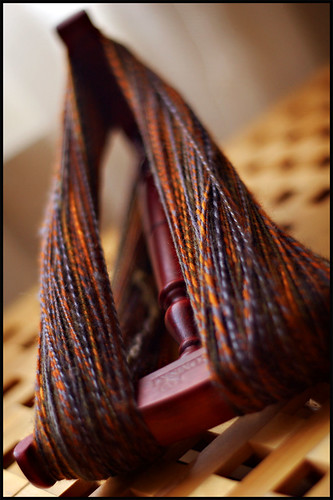
Washing handspun yarn is essential because it sets the twist, allowing the fiber to relax and adapt to its new configuration. Washing is also wonderful because, much like blocking your knitting, it will often erase or at least de-emphasizes mistakes, snags or tension issues. When taking it out of the bath, it's also a good idea to give it a few good *whacks* against the tub to even things out. Especially for beginners, skeins straight off the wheel may be far from balanced, but giving the yarn a bath will work wonders as a self-esteem booster. I've had particularly ugly yarns come out of the sink looking well-behaved and beautiful. Another of wool's many wonders.
Wash your yarn like you wash your sweaters - gentle soap, luke warm water, no agitation - squeeze out excess water and hang up to air dry. Weighting the bottom of the skein as it dries also works great for helping to balance your yarn.

When everything is dry, you can go nuts. Petting, smelling and general merry-making are all now acceptable activities for which to engage with your yarn. Whether or not knitting happens, no worry, handspun is beautiful as a stand-alone, boasting enough aesthetic prowess to hold it's own just about anywhere in the house.
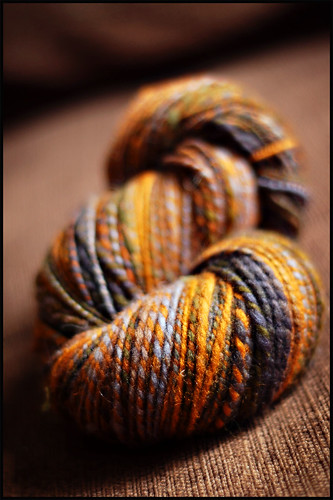
And that, my friends, about sums up this fast and loose version of handspinning a 2-ply yarn. This is just one of the many ways you can use a spinning wheel to make yarn, though. The possibilities are truly endless and if you really love having your hands on fiber, you probably won't ever tire of spinning.
I intend on covering a third portion of this series talking briefly about knitting with handspun and planning projects, but probably not immediately. My knitting time has been fruitful and inspiring lately (I have much to show you), and I don't have anything immediately in mind for my most recent batch of handspun. When I do, though, we'll talk more about knitting with handspun yarn.
I do hope everyone is enjoying the sun, it's been gorgeous around here - my spinning wheel loves all the open windows. Happy spinning!
Now, lets do some spinning, shall we?

Spinning is essentially putting twist into loose fibers to hold them together into a strong, continuous string or thread. Twist is, in fact, the very essence of spinning and mastering control over the amount of twist you choose to use will dramatically change your resulting yarn. Hard, durable yarns have lots of twist and are favored by weavers and rug makers for their ability to take hard knocks and stay intact. For handknitters, lighter, lofty yarns are often preferable and are less tightly spun. Of course this is an over-simplification, but you get the idea.

I'll be spinning a 2-ply yarn today, and the first step in the process is to spin singles (single plies of fiber). These spun fibers will then be plied together for the finished product. An important rule when plying: the direction of your twist in the singles must always be reversed when plying - thus equalizing the tension put on the fibers and forming a balanced yarn.
I like to think of twist as dormant energy - if you put too much into your singles and don't compensate for it while plying, one throws the other off balance.
I like to think of twist as dormant energy - if you put too much into your singles and don't compensate for it while plying, one throws the other off balance.

Above we have two bobbins of singles in more or less equal amounts. Before spinning I made sure to divide the fiber evenly into two parts in hopes of maximizing the yardage of the finished, plied yarn. You can see clearly on the bobbins how cleanly separated the color fields have spun out. If we were to knit this yarn up as-is, we would see clean, dramatic color stripes in our finished fabric. Plying them together, however, will essentially have the effect of mixing paint - the colors will come together somewhat randomly to diffuse or enhance one another, depending on their individual combinations. This is to me one of the best things about spinning plied yarns from hand-dyed fibers.

Before plying, I like to load my bobbins on a tensioned Lazy Kate, for ease and consistency of flow while plying. A Kate isn't absolutely necessary for plying yarns but I find it makes the job a whole lot easier and more enjoyable.
Plying is enjoyable and seems almost too easy in comparison to spinning singles - in a way the plies actually want to come together and relax as the tension of their twist is balanced. The amount of twist added while plying should more or less correspond to that in your singles, as I mentioned before, to achieve a no-fuss yarn.

With one hand pinching the yarn, I use another to separate and guide the plies as they flow off of the Kate. Plying can be rather hypnotic, not only as you watch colors combine and flow but also from the constant whirring of the wheel and mindless peddling of your feet. Very relaxing. Just don't do it while your cooking something on the stove. Seriously.
Before you know it, you'll have a nice, full bobbin of 2-ply yarn waiting patiently to come off the bobbin.

Now the spinning is done, but don't forget that "finishing" your yarn is an equally important (and enjoyable) part of the process that I shant forget to mention. Using a niddy-noddy, the back of a chair, or any other surface you can think to string yarn around, gently skein your yarn off of the bobbin in preparation for its inaugural bath.

Washing handspun yarn is essential because it sets the twist, allowing the fiber to relax and adapt to its new configuration. Washing is also wonderful because, much like blocking your knitting, it will often erase or at least de-emphasizes mistakes, snags or tension issues. When taking it out of the bath, it's also a good idea to give it a few good *whacks* against the tub to even things out. Especially for beginners, skeins straight off the wheel may be far from balanced, but giving the yarn a bath will work wonders as a self-esteem booster. I've had particularly ugly yarns come out of the sink looking well-behaved and beautiful. Another of wool's many wonders.
Wash your yarn like you wash your sweaters - gentle soap, luke warm water, no agitation - squeeze out excess water and hang up to air dry. Weighting the bottom of the skein as it dries also works great for helping to balance your yarn.

When everything is dry, you can go nuts. Petting, smelling and general merry-making are all now acceptable activities for which to engage with your yarn. Whether or not knitting happens, no worry, handspun is beautiful as a stand-alone, boasting enough aesthetic prowess to hold it's own just about anywhere in the house.

And that, my friends, about sums up this fast and loose version of handspinning a 2-ply yarn. This is just one of the many ways you can use a spinning wheel to make yarn, though. The possibilities are truly endless and if you really love having your hands on fiber, you probably won't ever tire of spinning.
I intend on covering a third portion of this series talking briefly about knitting with handspun and planning projects, but probably not immediately. My knitting time has been fruitful and inspiring lately (I have much to show you), and I don't have anything immediately in mind for my most recent batch of handspun. When I do, though, we'll talk more about knitting with handspun yarn.
I do hope everyone is enjoying the sun, it's been gorgeous around here - my spinning wheel loves all the open windows. Happy spinning!
4.09.2008
Anatomy of a Handspun: Part I
I recently heard someone say that spinning is a natural progression for any knitter. While I can't speak for everyone, I can say that when I think about how much I've learned about yarn since becoming a spinner, this statement definitely holds true for me. When you begin constructing and knitting with your own yarns, you're bound to reach a new understanding of what this fiber thing is all about, and that's a good day for everyone.
I received a lot of e-mail responses to my last post regarding the process of converting fiber to yarn. Lots of you want pictures! Do I detect many knitters on the brink of making a crossover? (Just remember, spindles are a cheap way to test the waters)(without causing marital problems) The art of spinning is something I am unqualified to present to you on any formal level, but I thought I'd do what I could and give you a visual journey through my own spinning process. This topic will span 2 to 3 posts, not only because I am wary of overwhelming non-spinners with too much foreign information, but because currently my personal spinning time is a rarity, and this current spinning project is literally in progress. I think it works best this way for all of us. Now, shall we begin?
Wool comes to handspinners in many different forms. In our case we'll be looking at hand-dyed roving, which seems to me one of the more popular ways urban spinners (with no space for cleaning or carding fleeces) like to roll.
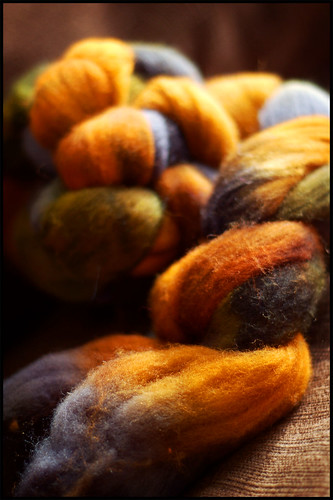
A roving is a continuous strip of combed or carded fibers to which a slight twist has been added (to keep everything everything together for dying, shipping, etc). Basically, a long, doughy strip of compressed wool. Rovings often come in braids after they've been dyed, like the one shown above. This particular beauty comes to us from the good folks at Interlacements in Colorado.
Unfurl the braid to see the roving in its entirety. The photo below shows the roving unbraided and reveals the dying scheme - spacial color fields of oranges, blues, and greens. Purdy, ain't it?

Roving is too dense to spin as-is and must be drafted first. Some spinners draft as they spin, others, like me, prefer pre-drafting. Drafting is essentially drawing the fibers out gently from one another to allow air into the spaces between individual fibers. When wool is drafted well it flows easily and consistently while spinning, which is desirable if you like your yarn nice and even. Notice below the difference in the fiber between my fingers and those that have yet to be drawn out. Wispy!

In the wrong mindset, drafting can be an annoying precursor to the good stuff, although I tend to enjoy it - preparing the fiber and getting to know the tactile qualities of your specific batch of wool adds a special layer to the process. Kind of like giving your fiber a massage.
Depending on what color-effects you're after, you may choose to tear the roving into strips and draft them individually. By doing this you essentially reduce the length of color repeats in your yarn - a quality you can manipulate in order to conjure up self-striping color patterns or other color tricks in your final yarn. With a well-dyed roving, you have a whole lot of possibilities - no two yarns will ever be exactly the same.
Below is a strip of roving (this time around, I split mine into 4) balled up on the window before being drafted.
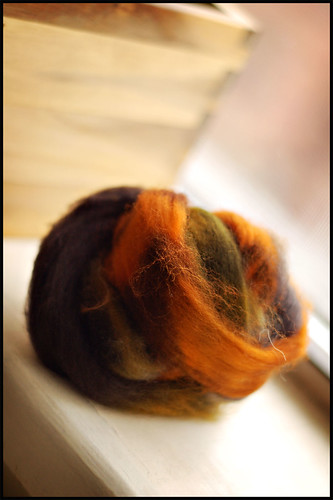
Drafting magically makes your fiber amount seem to multiply exponentially - what used to slink easily into the bottom of your basket as a tidy little roving now gently floats up over the edges - a sumptuous cloud of colorful wool bursting with potential, just waiting for a romp with your wheel. A rather delicate thing of beauty in itself (Note: not pet friendly, nor wind friendly for that matter).
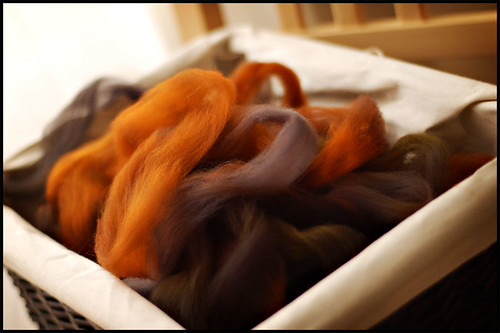
A nice big basket of pre-drafted fiber is a great thing to have around (see above if you own pets) - beautiful on its own, but always ready for a quick spin. And with this full basket, we conclude this evening's portion of our tour - fiber prep.
Up next we get down-n-dirty making yarn, followed by some form of knitting-with-handspun, although I'm not promising any projects... if I did, I may never get around to that third post! Stay tuned for more spinning fun!
I received a lot of e-mail responses to my last post regarding the process of converting fiber to yarn. Lots of you want pictures! Do I detect many knitters on the brink of making a crossover? (Just remember, spindles are a cheap way to test the waters)(without causing marital problems) The art of spinning is something I am unqualified to present to you on any formal level, but I thought I'd do what I could and give you a visual journey through my own spinning process. This topic will span 2 to 3 posts, not only because I am wary of overwhelming non-spinners with too much foreign information, but because currently my personal spinning time is a rarity, and this current spinning project is literally in progress. I think it works best this way for all of us. Now, shall we begin?
Wool comes to handspinners in many different forms. In our case we'll be looking at hand-dyed roving, which seems to me one of the more popular ways urban spinners (with no space for cleaning or carding fleeces) like to roll.

A roving is a continuous strip of combed or carded fibers to which a slight twist has been added (to keep everything everything together for dying, shipping, etc). Basically, a long, doughy strip of compressed wool. Rovings often come in braids after they've been dyed, like the one shown above. This particular beauty comes to us from the good folks at Interlacements in Colorado.
Unfurl the braid to see the roving in its entirety. The photo below shows the roving unbraided and reveals the dying scheme - spacial color fields of oranges, blues, and greens. Purdy, ain't it?

Roving is too dense to spin as-is and must be drafted first. Some spinners draft as they spin, others, like me, prefer pre-drafting. Drafting is essentially drawing the fibers out gently from one another to allow air into the spaces between individual fibers. When wool is drafted well it flows easily and consistently while spinning, which is desirable if you like your yarn nice and even. Notice below the difference in the fiber between my fingers and those that have yet to be drawn out. Wispy!

In the wrong mindset, drafting can be an annoying precursor to the good stuff, although I tend to enjoy it - preparing the fiber and getting to know the tactile qualities of your specific batch of wool adds a special layer to the process. Kind of like giving your fiber a massage.
Depending on what color-effects you're after, you may choose to tear the roving into strips and draft them individually. By doing this you essentially reduce the length of color repeats in your yarn - a quality you can manipulate in order to conjure up self-striping color patterns or other color tricks in your final yarn. With a well-dyed roving, you have a whole lot of possibilities - no two yarns will ever be exactly the same.
Below is a strip of roving (this time around, I split mine into 4) balled up on the window before being drafted.

Drafting magically makes your fiber amount seem to multiply exponentially - what used to slink easily into the bottom of your basket as a tidy little roving now gently floats up over the edges - a sumptuous cloud of colorful wool bursting with potential, just waiting for a romp with your wheel. A rather delicate thing of beauty in itself (Note: not pet friendly, nor wind friendly for that matter).

A nice big basket of pre-drafted fiber is a great thing to have around (see above if you own pets) - beautiful on its own, but always ready for a quick spin. And with this full basket, we conclude this evening's portion of our tour - fiber prep.
Up next we get down-n-dirty making yarn, followed by some form of knitting-with-handspun, although I'm not promising any projects... if I did, I may never get around to that third post! Stay tuned for more spinning fun!
